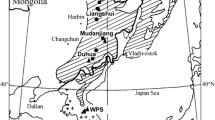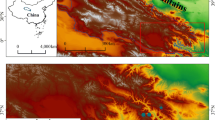Abstract
We analyzed the influence of climate change over the past 50 years on the radial growth of two tree species: Korean pine (Pinus koraiensis) and Yezo spruce (Picea jezoensis), located on Changbai Mountain, Northeast China, using a dendrochronology approach to understand factors that limit the altitude for tree species. Elevated temperatures increased the radial growth of Korean pine and decreased that of Yezo spruce. The positive response of tree growth to hydrothermal conditions was the key reason that the upper limit of elevation of Korean pine followed the temperature fluctuation pattern. Increased temperatures and precipitation and longer growing seasons accelerated Korean pine growth. As the temperature increased, correlations between Korean pine ring-width chronology and precipitation changed from negative to positive. In Yezo spruce, increasing monthly temperatures and inadequate precipitation during the middle and late parts of the growing season led to narrow growth rings, whereas decreasing monthly temperatures and sufficient precipitation during the late growing season promoted growth. Rising temperatures and adequate precipitation increases Korean pine growth, possibly elevating the upper range limit in altitude for this species. In contrast, Yezo spruce growth is negatively affected by warming temperatures and limited precipitation. Under future temperature increases and precipitation fluctuations, the upper limit altitude of Korean pine can reasonably be expected to shift upward and Yezo spruce downward.





Similar content being viewed by others
References
Barber V, Juday G, Finney B (2000) Reduced growth of Alaskan white spruce in the twentieth century from temperature-induced drought stress. Nature 405:668–673
Briffa K, Schweingruber F, Jones P, Osborn T, Shiyatov S, Vaganov E (1998) Reduced sensitivity of recent tree-growth to temperature at high northern latitudes. Nature 391:678–682
Büntgen U, Esper J, Frank D, Nicolussi K, Schmidhalter M (2005) A 1052-year tree-ring proxy for Alpine summer temperatures. Clim Dyn 25:141–153
Büntgen U, Frank D, Schmidhalter M, Neuwirth B, Seifert M, Esper J (2006) Growth/climate response shift in a long subalpine spruce chronology. Trees Struct Funct 20:99–110
Carrer M, Urbinati C (2006) Long-term change in the sensitivity of tree-ring growth to climate forcing in Larix decidua. New Phytol 170:861–872
Ciais P, Reichstein M, Viovy N, Granier A, Ogee J, Allard V, Aubinet M, Buchmann N, Bernhofer C, Carrara A (2005) Europe-wide reduction in primary productivity caused by the heat and drought in 2003. Nature 437:529–533
Cook E, Holmes R (1986) Users manual for program ARSTAN. Laboratory of Tree-Ring Research, University of Arizona, Tucson
Cook E, Krusic P, Jones P (2003) Dendroclimatic signals in long tree-ring chronologies from the Himalayas of Nepal. Int J Climatol 23:707–732
Cook E, Esper J, D’Arrigo R (2004) Extra-tropical Northern Hemisphere land temperature variability over the past 1000 years. Quatern Sci Rev 23:2063–2074
Cui M, He Y, Chen W, Chen Z, Zhou C, Wu T (2008) Dendrochronology of Chinese pine in Mulan-Weichang, Hebei Province: a primary study. Chin J Appl Ecol 19:2339–2345
D’Arrigo R, Jacoby G, Frank D, Pederson N, Cook E, Buckley B, Nachin B, Mijiddorj R, Dugarjav C (2001) 1738 years of Mongolian temperature variability inferred from a tree-ring width chronology of Siberian pine. Geophys Res Lett 28:543–546
De Oliveira EAD, Approbato AU, Legracie JR Jr, Martinez CA (2012) Soil-nutrient availability modifies the response of young pioneer and late successional trees to elevated carbon dioxide in a Brazilian tropical environment. Environ Exp Bot 77:53–62
Development Core Team R (2011) R: A language and environment for statistical computing. R Foundation for Statistical Computing, Vienna
Duan J, Zhang Q-B, Lv L, Zhang C (2012) Regional-scale winter-spring temperature variability and chilling damage dynamics over the past two centuries in southeastern China. Clim Dyn 39:919–928
Frank D, Esper J (2005) Characterization and climate response patterns of a high-elevation, multi-species tree-ring network in the European Alps. Dendrochronologia 22:107–121
Fritts H (1976) Tree-rings and climate. Academic Press, London
Hao Z, Dai L, He H (2001) Potential response of major tree species to climate warming in Changbai Mountain, Northeast China. Chin J Appl Ecol 12:653–658
Holmes R (1983) Computer-assisted quality control in tree-ring dating and measurement. Tree Ring Bull 43:69–78
Holmes R, Adams R, Fritts H (1986) Tree-ring chronologies of western North America: California, eastern Oregon and northern Great Basin, with procedures used in the chronology development work, including users manuals for computer programs COFECHA and ARSTAN. Laboratory of Tree-Ring Research, University of Arizona, Tucson, Chronology Series VI, p 182
Jacoby G, D’Arrigo R (1995) Tree-ring width and density evidence of climatic and potential forest change in Alaska. Global Biogeochem Cycles 9:227–234
Leng W, He H, Bu R, Hu Y (2006) The spatial distribution of constructive species of Northeast forest under the climate changing. Acta Ecol Sin 26:4257–4266
Li W (2004) Degradation and restoration of forest ecosystems in China. For Ecol Manage 201:33–41
Li GQ, Bai F, Sang WG (2011) Different responses of radial growth to climate warming in Pinuskoraiensisand Piceajezoen-sis var. komaroviiat their upper elevational limits in Changbai Mountain, China. Chin J Plant Ecol 35:500–511
Luckman B, Wilson R (2005) Summer temperatures in the Canadian Rockies during the last millennium: a revised record. Clim Dyn 24:131–144
Melvin T (2004) Historical growth rates and changing climatic sensitivity of boreal conifers. Ph.D. thesis, Climatic Research Unit, East Anglia, UK
Meyer F (1999) Pointer year analysis in dendroecology: a comparison of methods. Dendrochronologia 16:193–204
Salzer M, Kipfmueller K (2005) Reconstructed temperature and precipitation on a millennial timescale from tree-rings in the southern Colorado plateau, USA. Clim Change 70:465–487
Shao X, Wu X (1997) reconstruction of climate change on Changbai Mountain, Northeeast China using tree-ring data. Chin J Quat Sci 1:76–85
Stokes M, Smiley T (1996) An introduction to tree-ring dating. University of Arizona Press, Tucson
Vaganov E, Hughes M, Kirdyanov A, Schweingruber F, Silkin P (1999) Influence of snowfall and melt timing on tree growth in subarctic Eurasia. Nature 400:149–151
Walther G, Post E, Convey P, Menzel A, Parmesan C, Beebee T, Fromentin J, Hoegh-Guldberg O, Bairlein F (2002) Ecological responses to recent climate change. Nature 416:389–395
Wang M, Bai S, Tao D, Shan J (1995) Effect of rise in air temperature on tree-ring growth of forest on Changbai Mountain. Chin J Appl Ecol 6:128–132
Wilson R, Luckman B (2002) Tree-ring reconstruction of maximum and minimum temperatures and the diurnal temperature range in British Columbia, Canada. Dendrochronologia 20:257–268
Wilson R, Luckman B (2003) Tree-ring reconstruction of maximum and minimum temperatures and the diurnal temperature range in British Columbia, Canada. Dendrochronologia 20:257–268
Wilson R, D’Arrigo R, Buckley B, Büntgen U, Esper J, Frank D, Luckman B, Payette S, Vose R, Youngblut D (2007) A matter of divergence: tracking recent warming at hemispheric scales using tree-ring data. J Geophys Res 112:D17103. doi:10.1029/2006JD008318
Yonenobu H, Eckstein D (2006) Reconstruction of early spring temperature for central Japan from the tree-ring widths of Hinoki cypress and its verification by other proxy records. Geophys Res Lett 33:L10701
Yu D, Gu H, Wang J, Wang Q, Dai L (2005a) Relationships of climate change and tree-ring of Betula ermanii tree line forest in Changbai Mountain. Chin J For Res 16:187–192
Yu D, Wang S, Tang L, Dai L, Wang Q, Wang S (2005b) Relationship between tree-ring chronology of Larix olgensis in Changbai Mountains and the climate change. Chin J Appl Ecol 16:14–20
Zhang H, Han S, Li Y, Zhang J (2007) Reconstruction of temporal variations of precipitation in Changbai Mountain area over past 240 years by using tree-ring width data. Chin J Ecol 26:1924–1929
Zhu W, Pan Y, Yang X, Song G (2007) Comprehensive analysis of the impact of climatic changes on Chinese terrestrial net primary productivity. Chin Sci Bull 52:3253–3260
Acknowledgements
This research was financially supported by the Key Basic Research Project “973” (2010CB951301-5) and the China Bureau of Foreign Experts and the Ministry of Education of China (111 Program, Grant 2008-B08044). We are grateful to Lingzhi Chen for providing her 1963 field observation data and to Kun Wang and Haicheng Zhou for help the information in the CNR. The Administrative Committee of the Changbai Mountain Reserve Development Zone, Beijing Forestry University, Mr Jie Wang, Miao Sun, Liwei Wei and Minggang Yin provided invaluable help with our field investigations.
Author information
Authors and Affiliations
Corresponding author
Additional information
Project funding This research was financially supported by the Key Basic Research Project “973” (2010CB951301-5) and the China Bureau of Foreign Experts and the Ministry of Education of China (111 Program, Grant 2008-B08044).
The online version is available at http://www.springerlink.com
Corresponding editor: Chai Ruihai
Rights and permissions
About this article
Cite this article
Zhuang, L., Axmacher, J.C. & Sang, W. Different radial growth responses to climate warming by two dominant tree species at their upper altitudinal limit on Changbai Mountain. J. For. Res. 28, 795–804 (2017). https://doi.org/10.1007/s11676-016-0364-5
Received:
Accepted:
Published:
Issue Date:
DOI: https://doi.org/10.1007/s11676-016-0364-5




